11 Apr 2025
Unless you’re new to smol (hello!), you know we’re ALL about cutting carbon.
It’s our way of showing the planet a little love. And one of the best tools in our carbon-cutting-toolbox is the Life Cycle Analysis (LCA).
It’s like a health check-up for our products, measuring their environmental impact from start to finish. And our fabulous fabric conditioner has pulled in a fantastic set of results.
Could smol fabric conditioner be your next carbon-cutting swap?
life cycle analysis (LCA).
An LCA dives deep into every stage of a product’s life, measuring its carbon footprint at each step.
For our fabric conditioner, we wanted to know where most of the carbon comes from, which part of its life cycle is the biggest offender and how it stacks up against other branded fabric conditioners.
11 steps.
Our study covered the entire life cycle of the fabric conditioner, from raw ingredients to disposal:
- Sourcing & making the ingredients
- Sourcing & making the packaging
- Transporting ingredients to the factory
- Transporting packaging to the factory
- Making the fabric conditioner
- Sending the fabric conditioner to the smol factory
- Shipping smol boxes to Royal Mail
- Delivering smol boxes to your door
- Using the fabric conditioner in your washing machine at home
- Treating wastewater from your washing machine
- Disposing of the cardboard box
so, where’s the carbon coming from?
Turns out, a whopping 89% of the carbon emissions linked to our fabcon come from the “at-home-use” phase. Essentially it’s coming from the energy consumed by our friend the washing machine. The main culprit? Heating water for laundry.
The disposal of the packaging when it’s no longer required also contributes another 6.2%. These 2 steps together make up over 95% of our fabcon’s carbon footprint. And the good news is… there are easy ways for our customers to cut this down!
As for the production of ingredients? That’s responsible for just 0.4% of total emissions.
cool wash, big impact.
So here’s the first easy way to cut our fabric conditioner’s carbon footprint: turn down the temperature on your washing machine.
You’ll instantly use less energy. In fact dropping from 30°C to 20°C washes uses nearly 40% LESS energy ₁ And in more good news, smol laundry capsules dissolve quickly and clean effectively on a cold wash, and our fabric conditioner works just as well too!
Pro tip: you can also wash less often. Only launder clothes when they really need it- and you can find several brilliant ways to clean clothes without washing them here. Finally, try to stick to full loads. Half loads use nearly as much energy and water as full ones but clean far fewer clothes.
recycling matters.
And for legendary status in cutting our fabcon’s footprint… make sure to recycle the cardboard packaging your smol comes in.
Creating cardboard from recycled material uses 25% less energy than when making new card and every tonne of cardboard recycled saves 7k tonnes of water, 4k kW of electricity and 9 cubic yards of landfill space. ₂
smol vs. another brand.
And in the carbon showdown, smol fabric conditioner BEATS a rival brand by 76% LOWER carbon emissions!
That’s huge, thanks to our efficient sourcing, production and packaging processes.

refill for the win.
Want to cut even more carbon? Keep your bottle-for-life. Every fabric conditioner refill means one less single-use plastic bottle made, transported and binned. Simple, smart, and oh-so-satisfying.
Ready to freshen your laundry and lighten your carbon load? It’s never been easier to make a smol swap with a big impact.
₁ Which?. Switching from 40°C to 30°C saves 38% energy. Dropping from 40°C to 20°C saves 62%. Therefore dropping from 30°C to 20°C saves 38.7%.
₂ businesswaste.co.uk
